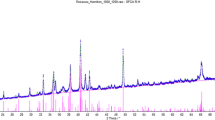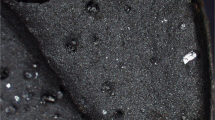Abstract
Two ferriphlogopite-1M crystals with a composition (K0.99Na0.01)Σ=1.00(Mg2.73Fe2+0.l7Fe3+0.08-Ti0.01)Σ=2.299[(Fe3+0.95Si3.05)Σ=4.00O10.17](OH)1.79F0.04 (sample S1) and (K102)Σ=1.02(Mg2.68Fe2+0.20Fe3+0.11-Mn0.01)Σ=3.00[(Fe3+0.95Si3.05)Σ=4.00O10.18](OH)1.75F0.07 (sample S2) occur within an alkali-carbonatic complex near Tapira, Belo Horizonte, Minas Gerais, Brazil. Each crystal was studied by single-crystal X-ray diffraction. The least-squares refinements of space group C2/m resulted in R values of 0.031 for S1 and 0.025 for S2. Results showed that Fe3+ substitutes for Si within the tetrahedral sites and that the Fe distribution is fully disordered. The octahedral sites are preferentially occupied by Mg. The presence of Fe3+ within the tetrahedral sheet produces increased cell edge lengths. For sample S1, a = 5.362 Å, b = 9.288 Å, c = 10.321 Å and the monoclinic β angle was: β = 99.99°. For sample S2, a = 5.3649 Å, b = 9.2924 Å, c = 10.3255 Å and the monoclinic β angle was: β = 99.988°. The tetrahedral rotation angle of a = 11.5° is necessary for tetrahedral and octahedral sheet congruency. The enlarged tetrahedral sites are regular, with cations close to their geometric center. Ferriphlogopites have identical mean bond lengths for M1 and M2 sites within standard deviation. The M1-O3 and M2-O3 bond lengths are longer than the mean so that O3 may articulate with the tetrahedra.
Similar content being viewed by others
References
Alietti E, Brigatti MF, Poppi L. 1995. The crystal structure and chemistry of high-aluminum phlogopites. Mineral Mag 59:149–157.
Bailey SW. 1988. X-ray diffraction identification of the poly-types of mica, serpentine, and chlorite. Clays & Clay Miner 36:195–213.
Beurlen H, Cassadanne JP. 1981. The brazilian mineral resources. Earth Sci Rev 17:177–206.
Bigi S, Brigatti ME 1994. Crystal chemistry and micro-structures of plutonic biotite. Am Mineral 79:63–72.
Brigatti MF, Davoli P. 1990. Crystal structure refinement of 1M plutonic biotites. Am Mineral 75:305–313.
Brigatti MF, Medici L, Saccani E, Vaccaro C. 1995. Phlogopites from the Alkaline-Carbonatite Complex of Tapira (Brazil): implications for their petrogenetical significance. Plinius 14:84–86.
Busing WR, Martin KO, Levi HS. 1962. ORFLS a FORTRAN crystallographic least-squares program. U.S. National Technical Information Service ORNL-TM-305.
Cruciani G, Zanazzi PF. 1994. Cation partitioning and substitution mechanisms in 1M-phlogopite: a crystal chemical study. Am Mineral 78:289–301.
Donnay G, Donnay JDH, Takeda H. 1964. Trioctahedral one-layer micas. II. Prediction of the structure from composition and cell dimensions. Acta Cryst 17:1374–1381.
Donnay G, Morimoto N, Takeda H, Donnay DH. 1964. Trioctahedral one-layer micas. I. Crystal structure of a synthetic iron mica. Acta Cryst 17:1369–1373.
Dyar MD. 1990. Mössbauer spectra of biotite from meta-pelites. Am Mineral 75:656–666.
Farmer GL, Boettcher AL. 1981. Petrologic and crystal chemical significance of some deep-seated phlogopites. Am Mineral 66:1154–1163.
Foley SF. 1989. Experimental constraints on phlogopite chemistry in lamproites: I. The effect of water activity and oxygen fugacity. Eur J Mineral 1:411–426.
Guggenheim S, Chang Y-H, Koster van Groos AF. 1987. Muscovite dehydroxylation: High-temperature studies. Am Mineral 72:537–550.
Guidotti CV, Dyar MD. 1991. Ferric iron in metamorphic biotites and its petrologic and crystallochemical implications. Am Mineral 76:161–175.
Hazen RM, Burnham CW. 1973. The crystal structures of one-layer phlogopite and annite. Am Mineral 58:889–900.
Hazen RM, Finger LW, Velde D. 1981. Crystal structure of a silica and alkali-rich trioctahedral mica. Am Mineral 66: 586–591.
Jakob J. 1925. X. beiträge zur chemischen konstitution der glimmer. I. Mitteilung die schwedischen manganophylle. Z Kristallogr 61:155–163.
Joswig W. 1972. Neutronenbeugungsmessungen an einem 1M-Phlogopit. N. Jahrbuch f. Mineralogie Monatshefte 1–11.
Meyrowitz R. 1970. New semimicroprocedure for determination of ferrous iron in refractory silicate minerals using a sodium metafluoborate decomposition. Anal Chem 42: 1110–1113.
Neal CR, Taylor LA. 1989. The petrography and composition of phlogopite micas from the Blue Ball kimberlite, Arkansas: a record of chemical evolution during crystallization. Mineral & Petrol 40:207–224.
Ohta T, Takeda H, Takéuchi Y. 1982. Mica polytypism: similarities in the crystal structures of coexisting 1M and 2M1 oxybiotite. Am Mineral 67:298–310.
Rancourt DG, Christie IAD, Royer M, Kodama H, Robert JL, Lalonde AE, Murad E. 1994. Determination of accurate [4]Fe3+, [6]Fe3+, and [6]Fe2+ site populations in synthetic annite by Mössbauer spectroscopy. Am Mineral 79:51–62.
Rancourt DG, Dang MZ, Lalonde AE. 1992. Mössbauer spectroscopy of tetrahedral Fe3+ in trioctahedral micas. Am Mineral 77:34–43.
Renner B, Lehmann G. 1986. Correlation of angular and bond length distortions in T04 units in crystals. Z Kristallogr 175:43–59.
Robinson K, Gibbs GV, Ribbe PH. 1971. Quadratic elongation: a quantitative measure of distortion in coordination polyhedra. Science 172:567–570.
Semenova TF, Rozhdestvenskaya IV, Frank-Kamenetskii VA. 1977. Refinement of crystal structure of tetraferriphlogo-pite. Soviet Phys Crystall 22:680–683.
Semenova TF, Rozhdestvenskaya IV, Frank-Kamenetskii VA, Pavlishin VI. 1983. Crystal structure of tetraferriphlogo-pite and tetraferribiotite. Mineral Z 5:41–49 (in Russian).
Siemens 1993. XSCANS System—Technical reference Siemens Analytical X-ray Instruments.
Steinfink H. 1962. Crystal structure of a trioctahedral mica phlogopite. Am Mineral 47:886–896.
Takeda H, Ross M. 1975. Mica polytypism: dissimilarities in the crystal structures of coexisting 1M and 2M1 biotite. Am Mineral 60:1030–1040.
Toraya H. 1981. Distortions of octahedra and octahedral sheets in 1M micas and the relation to their stability. Z Kristallogr 157:173–190.
Author information
Authors and Affiliations
Rights and permissions
About this article
Cite this article
Brigatti, M.F., Medici, L. & Poppi, L. Refinement of the Structure of Natural Ferriphlogopite. Clays Clay Miner. 44, 540–545 (1996). https://doi.org/10.1346/CCMN.1996.0440413
Received:
Accepted:
Published:
Issue Date:
DOI: https://doi.org/10.1346/CCMN.1996.0440413




